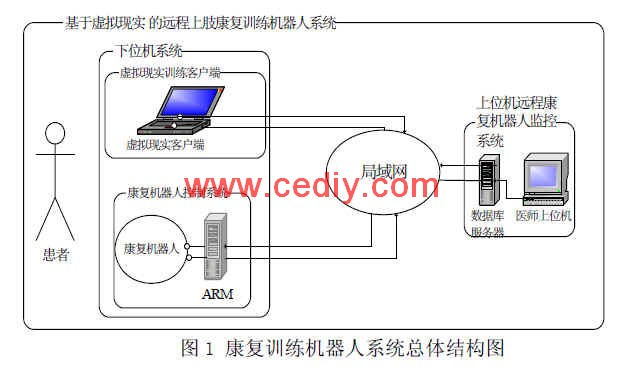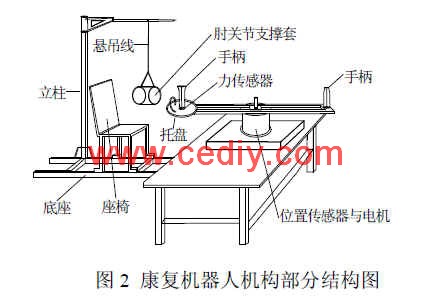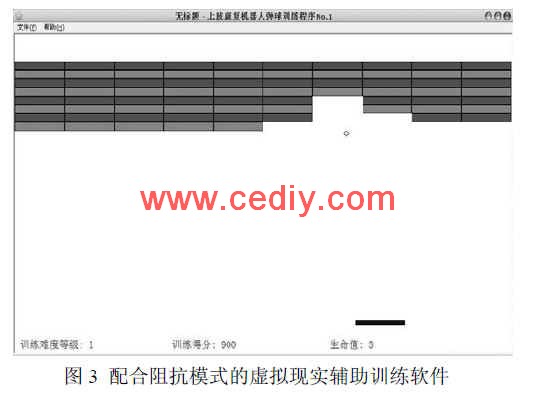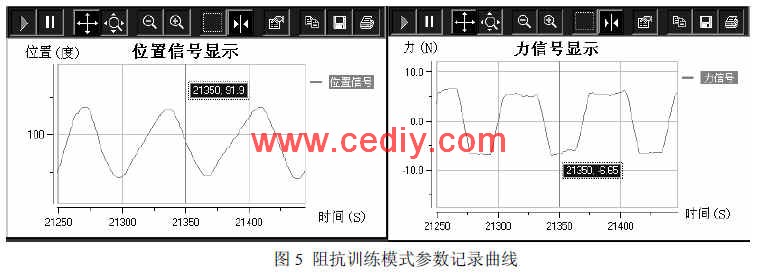Rehabilitation robot technology has received widespread attention from researchers and medical institutions in countries such as Europe and the United States, and has also achieved some valuable results. In 2006, Tobias Nef and others developed a virtual reality technology-based upper limb rehabilitation medical robot ARMIn[5 ]. Rutgers University and Stanford Medical School have done a lot of work on virtual environment-based remote rehabilitation robot systems [6]. Tsinghua University has developed a kind of upper limb rehabilitation equipment UECM, which can carry out two degrees of freedom running training in the plane [1].
In this paper, a virtual reality assisted rehabilitation training system is designed and developed for the existing upper limb rehabilitation training robot system in the laboratory, in order to stimulate the interest and motivation of the rehabilitation training, and to improve the effect of rehabilitation training.
1. General overview of the system
1.1 Rehabilitation training robot system overall structure diagram Rehabilitation training robot system can be mainly divided into upper computer remote monitoring system and lower computer system. The overall structure of the system is shown in Figure 1.
This article refers to the address: http://

1.2 Rehabilitation robot mechanism design
The part of the rehabilitation robot mechanism mainly comprises a seat part, a support part and a traction part, as shown in FIG. 2 . During training, the patient sits in a chair and lifts the patient's arm through the suspension line and the elbow support sleeve, and the patient's hand is fixed on the tray of the rehabilitation traction arm. 
1.3 Working principle of rehabilitation robot system
The rehabilitation training system consists of four parts: an auxiliary training client based on virtual reality technology, a rehabilitation robot control system (lower position machine), a doctor-side monitoring computer (host computer), and a network communication part. The rehabilitation robot control system is composed of ARM main control module, measurement control circuit, keyboard, LCD display circuit and storage device. When the passive training mode is running, the force and position sensor installed in the traction training robot arm will send the collected force and position signal of the patient to the ARM main control module after signal processing. The main control module is preprocessed and then passed through the lower position machine. The network module transmits the force and position information to the doctor-side monitoring host through the local area network, and the monitoring software draws a real-time curve of the velocity signal and the position signal, and accesses the background medical record database to record various state parameters in real time. The doctor judges the patient's rehabilitation according to the feedback information, and sets the rehabilitation training parameters through the upper computer, sends the control command to the lower computer, and the lower computer uses the corresponding control algorithm according to the parameters set by the doctor to send the control signal, which is amplified by the driving circuit. The motor is driven to control the movement of the traction training arm. When the active mode and the impedance mode are running, the virtual reality training client software and the remote monitoring software of the upper computer are simultaneously connected to the ARM embedded rehabilitation robot main control module through the local area network, and the main control module preprocesses the collected velocity and position signals. After that, it is sent to the host computer monitor and the virtual reality training program. The virtual reality assisted training software uses the received network data to transform into the coordinates of the objects in the virtual scene through the corresponding algorithm, and simultaneously implements the virtual reality assisted rehabilitation training process with the set virtual scene and human-computer interaction strategy. In this paper, two sets of virtual reality rehabilitation training programs are designed using windows GDI and OpenGL+3dmax, respectively, with active training mode and impedance training mode.
2, virtual reality assisted rehabilitation training client software development rehabilitation patients due to limb muscles in the state of retreat, it is easy to get bored with exercise, which is very unfavorable for the patient's rehabilitation process. To this end, this paper uses Windows GDI, OpenGL+3Dmax to design two well-interactive game programs as a patient-assisted rehabilitation training platform, so that patients can unconsciously complete the exercise during the game, and change the original negative exercise into a proactive participation exercise. .
2.1 Virtual reality assisted training software design with impedance training mode
2.1.1 Impedance training mode This training mode is suitable for patients who are about to recover. The limbs of these patients have gradually recovered their exercise ability. At this time, according to the rehabilitation situation of the patient, the patient can be affected by the robot during the rehabilitation exercise. The limb exerts a certain amount of damping force, which allows the patient to overcome the resistance when completing the movement, thereby strengthening the muscle strength and gradually returning to a normal state.
2.1.2 Programming This software uses a single document-based MFC application created by VC++6.0. After the game starts, the patient controls the horizontal movement of the mechanical arm to control the movement of the horizontal baffle in the virtual scene to bounce the ball and hit the rectangular brick above the picture. As shown in Figure 3. After the program starts running, draw the basic scene of the pinball game through GDI, the ball and the horizontal moving baffle to complete the basic initialization of the game parameters. Use the MySocket derived class of the CAsyncSocket class to create a framework form, initialize the training client socket, and encapsulate the network communication message response function. It also overloads the message response functions such as OnReceive(), OnAccept(), OnConnect(), OnClose(), etc. These functions respectively map the corresponding processing functions in the CMyView class. Immediately after the socket initialization is completed, it is connected to the lower computer server and begins to receive the position and velocity data transmitted by the lower computer. When the network data arrives, the program map calls the OnReceive() function in the CMyView class to complete the position signal data transmitted by the lower computer, and passes the formula (1).
Shippositon=(long)(-w*855/180) (1)
Where w is the received arm angle value, and shippositon is the coordinate point value of the converted baffle on the screen. The arm angle value is converted into the actual position value of the horizontal baffle in the virtual environment, and finally transmitted to the Moveship() function to complete the process of moving the baffle, collision detection, refreshing the scene, and the like. The horizontal baffle is initialized in the middle of the view area after the start of the program run, ie the robot arm is 90 degrees. When the patient moves the robot arm to the left and right, the lowering machine outputs a corresponding amount of damping force according to the degree of deviation from the 90 degree position. The program is divided into three difficulty levels, and all the bricks of each difficulty level are hit and the next difficulty level is entered. For each additional level, the program will speed up the falling of the ball to increase the difficulty of the game. The runtime program also records the patient's score and game health. 
2.2 Virtual reality assisted training software design with active training mode
2.2.1 Active Training Mode Introduction This training mode is suitable for patients with milder conditions. Although these patients have some movement disorders, they do not completely lose their athletic ability. Therefore, they can design some virtual scene games with good interactivity. The patient is fully autonomously using the rehabilitation robot for exercise.
2.2.2 programming
The entire software uses the win32 application created by VC++6.0, calling OpenGL library function development. The software's 3D models and other graphic materials with textures use off-the-shelf resources to ensure the quality of the graphics and the development efficiency. The auxiliary training software combines the active training mode to provide the patient with a wide 3D virtual scene, through the training arm, and assists a Logitech joystick to roam. The patient controls the change of the plane azimuth of the scene by the robot arm, and assists the game rocker. Responsible for the forward, backward, pitch angle and shooting firing of the scene character. The interactive training task that the patient needs to complete is to find the moving target and shoot the hit in the scene as soon as possible. As shown in Figure 4: 
The program is first provided by the WinMain() function provider in the Win32 application framework. When the window is successfully created, the MsgProc() window callback function calls the Init() function in the OpenGL framework to transform and adjust the OpenGL view. After the Windows window is generated, it will enter the main loop of GameLoop(). Here, we will call the Render() function in the OpenGL framework to perform the processing and display of the graphics we need. When the program exits, CleanUp() is called to clear the OpenGL connection. In terms of interaction, the program is initialized with Winsock 2.0 to establish a socket, and the position data of the robot arm transmitted by the lower computer is received through the local area network, and the plane rotation angle of the scene character is calculated by calculation. Thereby achieving the purpose of real-time interaction. Forward and backward, the change of the pitch angle and the launch of the bullet are realized by means of the keyboard button message event, and then the button of the game rocker driver is associated with the response to achieve the purpose of the joystick assist control. The program uses the mciSendString function and the sndPlaySound function to implement various sound effects during the game.
3. Experimental results During rehabilitation training, the patient's hand is fixed on the tray of the rehabilitation training robot arm. The doctor sets the exercise mode to active training and resistance training through the upper computer interface (doctor's side), and calls the corresponding virtual reality. The auxiliary training program carries out interactive rehabilitation training, and the results significantly improve the patient's enthusiasm for participating in rehabilitation training, the training time is significantly increased, and the patient can maintain a state of excitement and happiness. At the same time of patient training, the real-time curve of the upper computer interface is drawn normally. In the impedance training mode, the real-time training parameter curve is drawn as shown in Fig. 5, which can accurately reflect the patient's training state. After the training is finished, open the historical data record table of the medical record database, and you can see that the position data and the velocity data record are correct. 
5. Summary In summary, the rehabilitation robot system uses a combination of upper and lower machines to provide a vivid platform for patient rehabilitation training by designing two interactive training programs based on virtual reality technology. Freed from boring rehabilitation training. The experimental results show that the designed auxiliary training program can better meet the requirements of patients for active training and resistance training mode. In the future research, it is necessary to further overcome and improve the impact of network delay on the real-time interaction between patients and virtual environments.
The author's innovation is: This article develops a novel based on the lack of good interaction between human and machine and the tedious shortness of the training mode in the traditional rehabilitation equipment-based training for stroke patients and upper limb injured patients. Upper limb assisted rehabilitation training system for virtual reality and computer networks. The system, in conjunction with the active mode and impedance mode of rehabilitation training, can provide a fun and well-interactive rehabilitation training process for patients.
Ningbo Autrends International Trade Co.,Ltd. , https://www.ecigarettevapepods.com